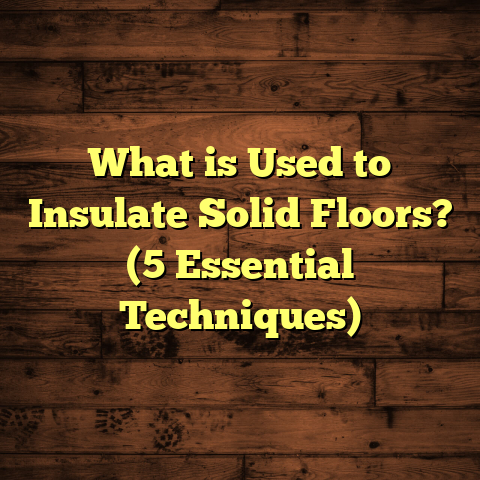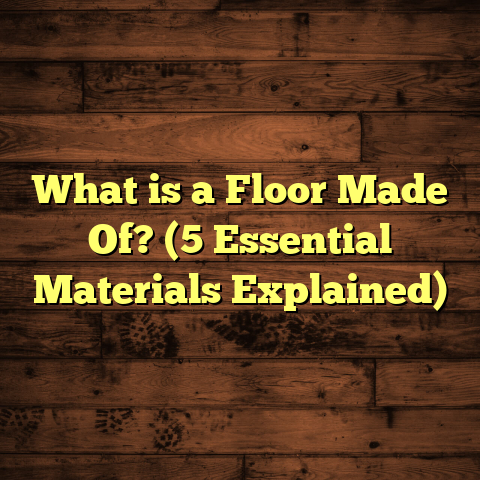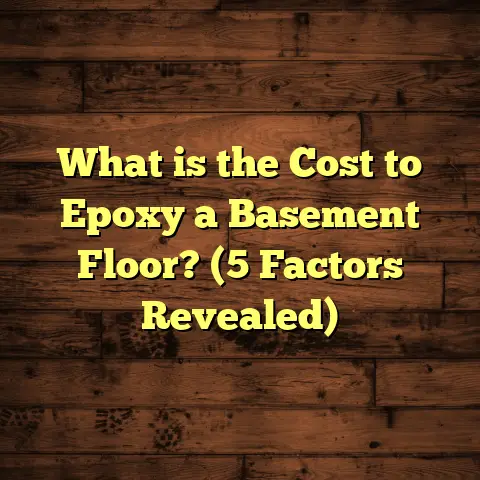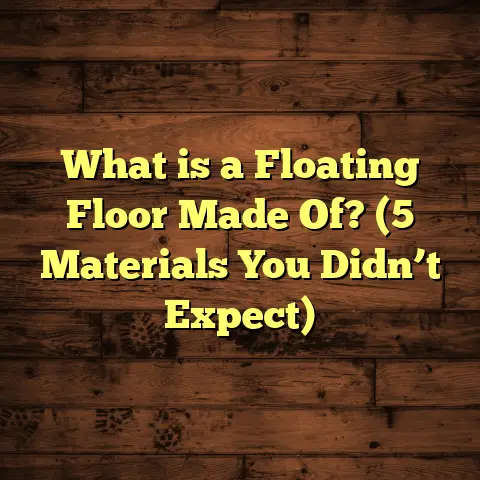What is Epoxy Flooring Cost? (5 Key Factors You Must Know)
I still remember the first time a client told me they thought epoxy flooring would be a simple “buy and pour” job. They were shocked when I walked them through the actual costs and the work involved. They assumed epoxy floors were cheap and easy—just slap on the coating and done. Boy, were they surprised! It’s a pretty common mistake. People hear “epoxy flooring” and imagine it’s just an inexpensive DIY project or a low-cost fix. But in reality, there’s a lot more to it.
I’ve been in the flooring business for years now, and over time, I’ve learned that understanding the true cost of epoxy flooring can save you from nasty surprises. So, here’s the deal: I’m going to break down exactly what epoxy flooring is and deep dive into the five key factors that influence its cost. Along the way, I’ll share some personal stories, real-world data, and practical advice to help you get the best floor for your money.
What is Epoxy Flooring?
Let’s start with the basics. What is epoxy flooring anyway?
Epoxy flooring is a type of surface coating made by mixing two main components: a resin and a hardener. When these are combined, they create a chemical reaction that turns liquid into a tough, plastic-like finish. Once cured, it forms a super durable, glossy layer on top of concrete floors.
Think of it like a shell—this shell protects the concrete underneath while giving the floor a shiny, modern look that’s easy to clean. It’s popular not just because it looks good but because it’s incredibly strong and resistant to damage from heavy foot traffic, chemicals, spills, and stains.
Why Is Epoxy Flooring So Popular?
I’ve installed epoxy floors in places ranging from busy warehouses to cozy home garages. One thing I noticed early on was how versatile this flooring really is.
- Durability: Epoxy floors can last many years without cracking or peeling if installed properly.
- Low Maintenance: You don’t have to wax or polish like traditional floors. A simple mop or sweep keeps them looking great.
- Safety: You can add anti-slip additives for safer footing.
- Aesthetics: From solid colors to metallic finishes and decorative chips, epoxy floors can be customized to fit many tastes and needs.
- Cost-Effective: Compared to expensive tile or hardwood installations, epoxy offers a budget-friendly alternative with a long lifespan.
I once helped remodel a commercial kitchen where they switched from tile to epoxy because it was easier to clean and didn’t have grout lines where bacteria could hide. That project taught me just how practical epoxy floors are in environments where cleanliness is key.
How Does Epoxy Flooring Work?
The process starts with your concrete floor. Epoxy doesn’t work well on wood or carpet; it needs concrete or similarly porous surfaces to bond.
Once the floor is clean and prepped (more on that later), the epoxy mixture gets applied in layers. Usually, there’s a primer coat followed by one or two topcoats. Each layer cures—hardens—over 24 to 72 hours depending on conditions.
The result? A smooth, tough surface that sticks tightly to your concrete slab.
5 Key Factors That Affect Epoxy Flooring Cost
Now that you know what epoxy flooring is, let’s talk about what influences the price. Understanding these five key factors has helped me give accurate estimates and avoid confusion with clients.
1. Size of the Area
I can’t stress this enough—square footage matters big time.
When people ask me for an estimate, the first question I ask is: “How much area are we talking about?”
Why? Because all your material costs (epoxy resin, hardener, primers) and labor hours scale with size.
For example:
- A small 200 sq ft garage might cost between $600–$2,400.
- A larger 1,000 sq ft warehouse could be $3,000–$12,000.
- And commercial spaces larger than 5,000 sq ft easily go over $20,000.
Here’s what I usually tell clients: The bigger your floor, the more you pay overall—but per square foot prices can sometimes decrease slightly due to efficiencies in labor and bulk purchasing.
To put things in perspective: According to HomeAdvisor’s data, epoxy flooring costs range widely from $3 to $12 per square foot, mainly depending on size but also other factors we’ll cover next.
Why does size affect cost so much?
Because epoxy installation isn’t just about pouring liquid on concrete. It involves prep work, mixing materials carefully, applying multiple coats evenly, and curing time—all require labor hours that grow with size.
One time I worked on a 3,000 sq ft manufacturing floor. The client thought they could get away with a quick job—but prepping that much concrete took days alone! Grinding rough spots, fixing cracks—it all adds up quickly when the floor is huge.
2. Type and Quality of Epoxy Used
Not all epoxy coatings are created equal. This often surprises people who assume epoxy is just one product.
There are several types of epoxy formulations available:
- Standard solid color epoxy: The most common and least expensive option.
- Metallic epoxy: Uses metallic pigments to create swirling patterns resembling marble or stone.
- Quartz-filled epoxy: Adds quartz granules for texture and slip resistance.
- Chemical-resistant epoxy: Formulated for industrial environments exposed to harsh chemicals.
- UV-resistant epoxy: Prevents yellowing or degradation from sunlight exposure.
- Antimicrobial epoxy: Contains additives that inhibit bacterial growth (great for kitchens or hospitals).
Each type varies in price according to complexity and materials used.
Material cost range examples:
- Solid color: $3–$5 per sq ft
- Metallic: $7–$12 per sq ft
- Quartz-filled: $5–$8 per sq ft
- Specialty industrial epoxies: $10+ per sq ft
I usually recommend mid-range epoxy for residential use since it balances durability with cost-effectiveness. But for commercial or industrial jobs where performance matters most, investing in specialized formulas pays off long-term.
Personal anecdote:
I installed metallic epoxy in a car showroom once. The client wanted something eye-catching but durable enough for tire traffic and spills. It cost about twice as much as regular epoxy but gave the space a unique look that customers loved.
3. Floor Preparation Requirements
This factor can make or break your project budget—and it’s often overlooked.
Epoxy only sticks well if your concrete floor is in good shape. That means no oil stains, cracks, dust buildup, or old coatings interfering with adhesion.
Preparation can involve:
- Cleaning oil and grease stains
- Grinding down bumps or rough spots
- Filling cracks or holes with patch compounds
- Removing old paint or coatings via shot blasting or sanding
All this prep work costs time and money—usually between $1 and $4 per square foot depending on severity.
I once had a client with an old garage floor covered in decades of oil stains and paint layers. The prep alone took three days of grinding before we could even apply the first coat of epoxy.
Skipping proper prep leads to peeling and bubbling later—which means spending more on repairs.
Quick tip:
If your concrete floor looks rough or has stains, budget extra for prep work upfront. It’s worth it.
4. Labor Costs
Labor is often the biggest chunk of your final bill after materials.
Professional installers charge based on:
- Project size
- Complexity of prep
- Number of coats applied
- Customization (like decorative flakes or slip additives)
Typical labor rates range from about $2 to $7 per square foot depending on your location and contractor experience.
Hiring experienced professionals matters—a lot. Epoxy installation requires precise mixing ratios and timing to prevent issues like bubbles, uneven thickness, or poor curing.
Many homeowners try DIY kits thinking they’ll save money but end up with floors that peel or discolor within months requiring costly fixes later. I’ve done plenty of repair jobs on poorly done DIY epoxy floors—trust me when I say professional labor pays off.
5. Additional Features and Customization
Want some extras? They’ll add to your cost but can make your floor safer and more attractive.
Some popular add-ons include:
- Anti-slip additives: Tiny grit particles mixed into epoxy for better traction (costs about $0.50–$1 per sq ft extra).
- Color flakes or quartz chips: Decorative elements sprinkled over wet epoxy then sealed with clear coats ($2–$5 per sq ft).
- Metallic finishes: Pigments blended into resin create swirling patterns ($7+ per sq ft).
- Logos or custom designs: Hand-painted or stenciled details can be pricey depending on complexity.
Adding these features means more prep time, extra materials, and skilled labor—which all increase cost but can transform your floor from basic to beautiful.
Breaking Down Real Costs: Case Studies & Research
Let me share some real numbers from projects I’ve been part of along with published data sources so you get an even clearer picture:
| Project Type | Size (sq ft) | Epoxy Type | Prep Required | Addons | Total Cost | Cost Per Sq Ft |
|---|---|---|---|---|---|---|
| Residential garage | 400 | Solid color | Moderate (grind) | Anti-slip | $2,800 | $7 |
| Commercial kitchen | 1,200 | Antimicrobial | Heavy (clean/grind) | None | $12,000 | $10 |
| Warehouse floor | 3,500 | Standard solid | Minimal | None | $12,250 | $3.50 |
| Car showroom | 1,000 | Metallic | Moderate | Flakes + anti-slip | $11,000 | $11 |
| Industrial chemical plant | 5,000 | Chemical-resistant | Heavy | Anti-slip | $80,000 | $16 |
What does this tell us?
- Smaller residential projects tend to have higher costs per square foot due to minimum labor charges.
- Commercial projects often require specialized epoxies driving prices up.
- Preparation level heavily impacts cost regardless of project size.
- Decorative customization significantly raises prices but adds value.
- Industrial applications have the highest costs because of extreme durability requirements.
How Can You Estimate Your Own Epoxy Flooring Cost?
Here’s a simple step-by-step method I suggest:
- Measure your floor area (length × width).
- Decide on epoxy type based on your needs (solid color vs metallic vs specialty).
- Assess floor condition—will it need heavy cleaning or crack repair?
- Choose desired features like anti-slip or decorative flakes if any.
- Get local labor rates by contacting installers or using online tools like FloorTally that factor in your location’s market prices.
Multiply material cost per sq ft by area + prep + labor + extras for a rough estimate.
My Experience With DIY vs Professional Installation
One story stands out about DIY epoxy attempts. A friend decided to save money by buying an epoxy kit online and doing their garage floor themselves.
They skipped grinding the concrete properly and didn’t mix hardener ratios precisely. Within three months, the floor started peeling in patches where moisture got trapped underneath.
I stepped in later to fix it properly—grinding down those bad spots, doing full prep work, and applying professional-grade epoxy.
The total repair cost was double what they saved trying to DIY initially!
If you’re handy and confident in following instructions meticulously, DIY might work for small areas with minimal prep needed. But when in doubt—hire pros who know the tricks of the trade.
What About Maintenance Costs?
Epoxy floors are low maintenance but not zero maintenance.
Here’s what you can expect:
- Regular sweeping/mopping keeps dirt off surface (no wax or polishing needed).
- Avoid harsh chemicals that could degrade epoxy over time (stick to manufacturer recommendations).
- Small scratches can be buffed out; bigger damage requires touch-ups with epoxy kits or professional repair.
I recommend budgeting around $100-$300 every few years for maintenance depending on usage intensity.
Common Questions I Get About Epoxy Flooring Costs
Can I do epoxy flooring myself?
You can—but be prepared for prep work and strict mixing/curing rules. Mistakes mean short lifespan and extra repair costs.
How long does epoxy flooring last?
With proper installation and maintenance, 10–20 years is normal. Industrial floors can last even longer with heavy use.
Does temperature affect curing time?
Yes! Cold environments slow curing; warm speeds it up but too hot risks bubbles forming during application.
Will my garage floor crack under epoxy?
Epoxy won’t stop concrete cracks but can help protect against future damage if base slab is sound. Cracks need repair before application.
Final Thoughts
Epoxy flooring is an incredible option for durable, stylish surfaces—but understanding cost factors helps you make smarter choices without regrets later on.
Whether you want a simple garage upgrade or a dazzling showroom floor, remember these five factors:
size, epoxy type, prep work, labor, and custom features all shape your total investment.
Spending time on preparation and choosing quality materials pays off big time by avoiding premature repairs and keeping your floors looking great for years.
If you’re planning an epoxy project soon or just weighing options—feel free to ask me anything about costs or process! I’m here to help you get your floor right the first time around.
This article should give you plenty of insights from both hands-on experience and data-backed research so you’re ready for whatever question comes up next about epoxy flooring costs!





